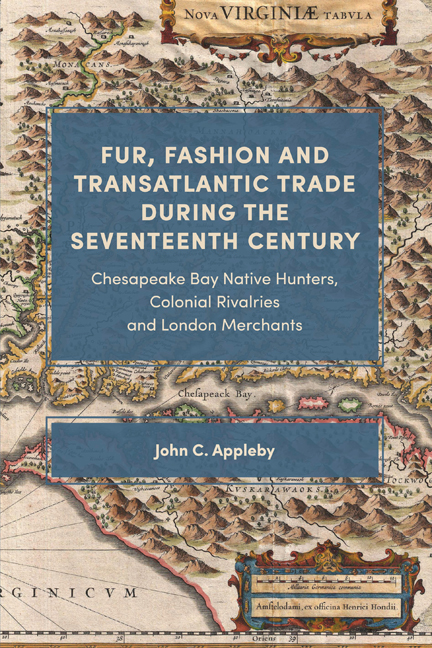 Fur, Fashion and Transatlantic Trade during the Seventeenth Century
Fur, Fashion and Transatlantic Trade during the Seventeenth Century Book contents
- Frontmatter
- Contents
- Acknowledgements
- A Note on Conventions
- Abbreviations
- Maps
- Introduction
- 1 Fur and Fashion: The Infrastructure of a New Trade
- 2 Commerce and Colonization: The Emergence of the Fur Trade in Chesapeake Bay
- 3 Trade and Rivalry: The Promise of Expansion and Innovation during the 1630s
- 4 Trade, Rivalry and Conflict during a ‘Time of Troubles’ from 1640 to 1660
- 5 Commercial Change and Conflict: Contrasting Experiences after 1650
- 6 Trade, Consumption and Industry: Transatlantic Constraints on the Bay Trade
- Conclusion
- Appendix
- Select Bibliography of Works Consulted
- Index
Introduction
Published online by Cambridge University Press: 15 December 2020
- Frontmatter
- Contents
- Acknowledgements
- A Note on Conventions
- Abbreviations
- Maps
- Introduction
- 1 Fur and Fashion: The Infrastructure of a New Trade
- 2 Commerce and Colonization: The Emergence of the Fur Trade in Chesapeake Bay
- 3 Trade and Rivalry: The Promise of Expansion and Innovation during the 1630s
- 4 Trade, Rivalry and Conflict during a ‘Time of Troubles’ from 1640 to 1660
- 5 Commercial Change and Conflict: Contrasting Experiences after 1650
- 6 Trade, Consumption and Industry: Transatlantic Constraints on the Bay Trade
- Conclusion
- Appendix
- Select Bibliography of Works Consulted
- Index
Summary
By a peculiar combination of opportunistic probing and visionary imagining, Chesapeake Bay became the location for the first successful English colony in North America. Following a period of successive failures, which included Sir Walter Raleigh's attempted settlement of Roanoke during the 1580s, the tiny outpost of Jamestown, established in 1607, paved the way for the emergence of colonial Virginia. It experienced a harrowing beginning. Lacking a successful model for colonization and left in the hands of private enterprise – the Virginia Company of London – Jamestown nearly succumbed to a deadly combination of disease and demoralization. Indian hostility, which culminated in a devastating attack on the small colony in 1622, also took a toll. It is, in the words of one recent study, ‘the creation story from hell’. Yet the settlement survived, outliving the collapse of its parent company in 1624. Indeed, its persistence and emerging profitability created an encouraging environment for the establishment of another colony, a decade later. But the new settlement of Maryland, under the authority of a Catholic lord proprietor, was an unwelcome intrusion, threatening the projection of a ‘greater Virginia’. Relations between these neighbouring, but rival, colonies dramatically re-shaped the Chesapeake, injecting intense competition for trade and territory into an emergent colonial world.
Economically, both colonies became wedded to the cultivation of tobacco. Its rapid spread during the 1620s and beyond secured the future of the newcomers, providing a profitable cash crop dependent on expanding consumption across the Atlantic. Over the course of the seventeenth century, exports from the Bay increased at a staggering rate, to the financial benefit of colonial planters, London merchants and the monarchy. Despite some diversification, it was the mainstay of economic development. The emergence and elaboration of a distinctive tobacco culture left an indelible imprint on the evolution of the Chesapeake colonies. Within a few decades the demands of a labour-intensive and exploitative agricultural system focused the attention of settlers on land, encouraging early expansion along the rivers. According to Robert Beverley, author of the earliest colonial history of Virginia, published in London in 1705, it provided an incentive for the newcomers with alarming consequences for the natives.
- Type
- Chapter
- Information
- Fur, Fashion and Transatlantic Trade during the Seventeenth CenturyChesapeake Bay Native Hunters, Colonial Rivalries and London Merchants, pp. 1 - 12Publisher: Boydell & BrewerPrint publication year: 2021


